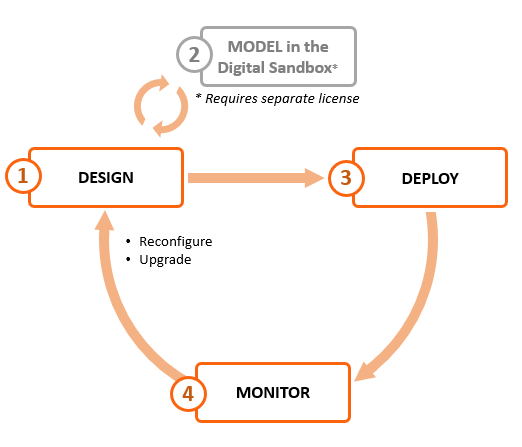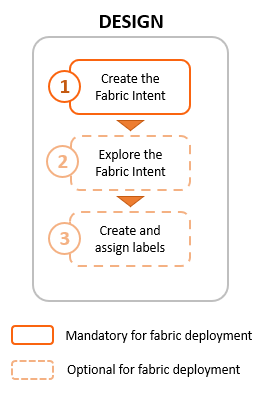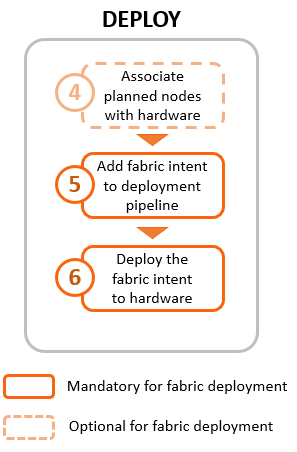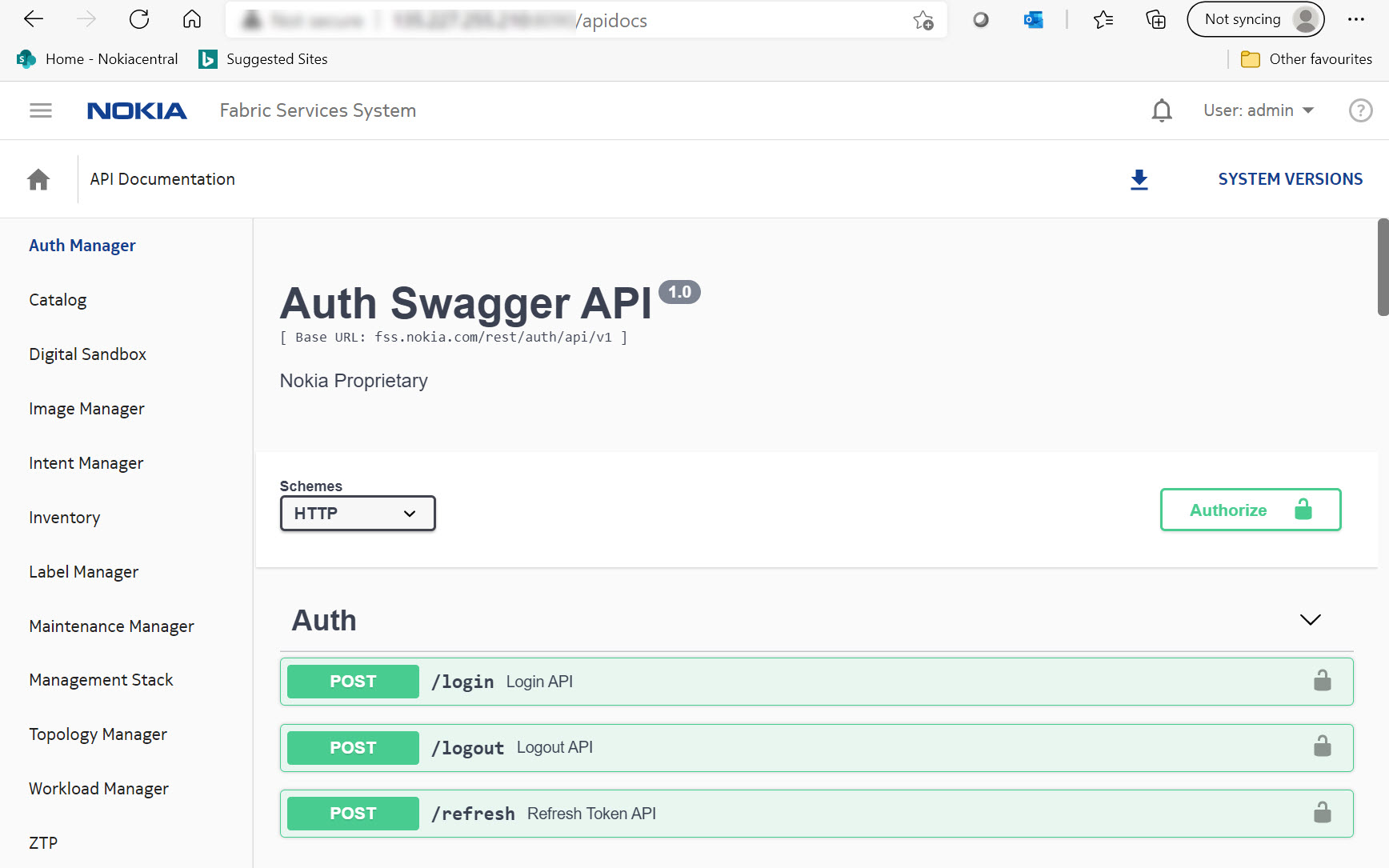Overview
The Fabric Services System supports intent-based automation for the management of data center fabrics, including:
- planning, designing, and validating a prospective fabric. These are sometimes called "Day 0" activities, and precede actual deployment.
- deploying a planned fabric configuration to hardware for the first time; also, designating resources within your deployed fabric for allocation to specific sources of demand upon its traffic and processing capacity. These are sometimes called "Day 1" activities, and pertain to the deployment itself.
- telemetry monitoring, state monitoring, and subsequent re-configuration of a fabric. These are sometimes called "Day 2+" activities, and are performed some time after the initial deployment.
This User Guide describes how to use the system's Graphical User Interface (GUI) to design, test, and manage your data center fabric and the to manage the workloads that place storage and processing demands upon them.
Concepts
The Fabric Services System uses the following concepts for describing and managing the elements of a fabric:
- Fabric: a group of switches that are managed as a single logical unit. A single data
center can include many complementary and mutually
supporting fabrics. These fabrics form an
structured "underlay" onto which connections and
services can be superimposed.
Fabrics are designed in a hierarchical structure. Typically this structure extends:
- from one or more backbone nodes, providing a gateway that manages communication externally to a WAN
- to one or more spine nodes that aggregate and distribute traffic
- to a collection of leaf nodes each associated with one or more spine nodes
- and from those leaf nodes through edge link interfaces to termination points
Although that description is typical, the presence or absence, size, and role of each level varies widely in actual fabric designs.
- Fabric intent: a set of node configurations that, when deployed to hardware, result in a functioning fabric. An intent gathers and deploys all of the required node configuration tasks into a single transaction, which then deploy successfully or not at all. If the deployment of any participating node's configuration fails at any point, the entire transaction is rolled back to restore all of the participating nodes to their state before the deployment of the intent began.
- Workload: a single source of demand upon a data center's fabrics. For example, all of the traffic from a single customer, or tenant, could be directed to only those resources encompassed by a particular workload intent. A workload is an overlay that can be superimposed upon the fabric's previously configured underlay structure.
- Workload intent: a set of node configurations pertaining to a specific subset of
fabric resources (one or more fabrics, subnets, and sub-interfaces). After the
workload intent is defined and its configuration data has been deployed to
participating nodes, the fabric resources encompassed by a workload intent can be
made available to manage a particular workload.
Like a fabric intent, The Fabric Services System deploys a workload intent to all participating nodes as a single transaction. This ensures that the entire deployment succeeds completely, or else fails completely and cleanly, leaving nodes in their pre-deployment states.
Life cycle of a fabric
The Fabric Services System provides tools to assist you in designing, deploying, and managing your data center fabric using the high-level cycle shown in Fabric life cycle.

Design the fabric intent
Using the Fabric Services System, you can design a new fabric with a few clicks. The system then creates a detailed fabric intent that identifies all of the necessary nodes and includes all of the configuration files necessary to provision those nodes when they are available.
You can review and modify this fabric intent before proceeding with deployment, using the system's built-in deployment system to reconfigure participating nodes.
During design, you indicate whether you are designing a fabric intent for deployment to real hardware, or to the Fabric Services System Digital Sandbox, a simulator where you can validate prospective fabric designs. The Digital Sandbox is described in Model in the Digital Sandbox.

To create the initial design for your fabric intent, you first select a Nokia certified fabric template and then configure some basic parameters. The system then generates a recommended topology for the fabric you described. The procedure for creating a fabric intent is described in Fabric intents.
After creating your fabric intent, you can (optionally) explore the fabric topology and view details about its constituent nodes and links. The procedure for viewing these details is described in Fabric intents.
Labels are tags that help you group and organize fabric objects according to specific criteria. You can create labels in the Label Factory and then assign them to fabric intents or to objects within a fabric intent.
Labels are a powerful tool you can use to identify a group of objects that can then be subject to collective actions, such as software updates. For example, you can create a label and apply it to a group of items that are subject to a particular upgrade. Then, you can apply the upgrade to all of the nodes with that label as a single action, instead of upgrading them individually.
For the procedures to create and assign labels, see Labels.
Model in the Digital Sandbox
If you have purchased the license for the Fabric Services System's Digital Sandbox, you can deploy your fabric to a virtual environment to evaluate its design without relying on physical hardware.
The Digital Sandbox is a network simulator that can emulate data center fabric designs (underlays) and the workload constraints configured upon those fabrics (overlays). Each SR Linux node within the fabric is emulated as its own virtual machine within the cluster, running its own copy of the SR Linux operating system.
In its current form, the Digital Sandbox can emulate a region, the structures of fabrics within that region, and the workload constraints that are configured upon those fabrics (including the edge links that are referred to by the workload). It does not yet simulate dynamic features like traffic flow between the simulated nodes and their endpoints.
Deploy the fabric intent
When you are satisfied with the fabric design, you can use the system to deploy your fabric intent to physical hardware.

Before deployment, you can associate any planned node in the fabric intent with its available, physical counterpart by providing the corresponding hardware serial number. You can associate individual nodes directly in the UI, or associate nodes in bulk by exporting a spreadsheet from the fabric intent, adding the necessary information for each node, and then re-importing the spreadsheet.
For the procedure to associate nodes individually or in bulk, see Inventories.
Whether you have performed this association or not, you can then add the fabric intent to the deployment pipeline. This pipeline manages all of the intents awaiting deployment, of which there can be many when multiple operators are simultaneously designing and maintaining multiple fabrics.
After the fabric intent is in the deployment pipeline, you can deploy the fabric. The system deploys configuration data to all of the participating, available nodes as a single transaction. The procedure for deployment is described in Fabric intents.
Even if none of the fabric's planned nodes are available when you design your fabric intent, you can still proceed with deployment. The system can deploy the planned fabric onto nodes as they become available; the fabric intent persists in the deployment pipeline until the entire deployment is complete. This allows you to plan a large fabric at the outset, and then deploy it in segments as the hardware become available over time.
Monitor the fabric intent
You can use the Operations features of the Fabric Services System to monitor the behavior of your fabric. These tools clearly signal any failure or design deviation, enabling you to take remedial steps as quickly as possible.
Repeat the cycle
As node replacement or software updates become necessary, you can use the system's design capabilities to again plan the necessary changes as a new version of the existing fabric intent. You can also model the planned update in the Digital Sandbox before deployment.
When the updated design is satisfactory, you can use the system's deployment capabilities to commit the changes to your working fabric.
You can repeat this cycle as often as needed throughout the lifetime of your fabric.
Workload VPN intents
The fabrics you deploy within a data center can carry traffic belonging to many customers (or "tenants"), all of which impose their own traffic, processing, and storage demands.
The Fabric Services System allows you to define a set of fabric resources that can be used to support an individual workload. This distributes the traffic and processing load efficiently over your fabric, and ensures that a tenant has reliable access to their share of the fabric's capacity. The tool that the Fabric Services System uses to allocate fabric resources is the workload intent.
A workload intent can encompass one or more fabrics. It identifies a set of subnets and their sub-interfaces within the participating fabrics to be made available to a particular source of demand. Sub-interfaces can be configured with Quality of Service (QoS) settings to prioritize traffic and Access Control Lists (ACLs) to accept or reject traffic originating from, or headed to, specific IP addresses.
The Fabric Services System uses the concept of an intent to encompass the set of node configurations that embody the workload intent. The system deploys the workload intent to all participating nodes as a single transaction. This approach ensures that the entire deployment succeeds completely, or else fails completely and cleanly to facilitate another attempt.
Procedures for creating and deploying a workload VPN intent can be found in Workload VPN intents.
Maintenance intents
A maintenance intent identifies a set of nodes and a configuration change that the Fabric Services System deploys to those nodes.
The Fabric Services System supports two types of maintenance intent:
- software changes, which upgrades or downgrades the SR Linux software version running on one or more nodes within a single fabric.
- node replacement, which updates the hardware association for an existing node to a new piece of matching hardware with a different serial number, and downloads the necessary configuration files to the new node so that it can fully resume the role of the hardware it replaced.
Procedures for creating and deploying a maintenance intent can be found in Maintenance intents.
Additional resources
You can obtain more information about the Fabric Services System user interface and its API from the other documents in the Fabric Services System documentation suite.
For the API, more information is available from the Swagger interface directly in the Fabric Services System UI.
Documentation resources
| Document | Description |
|---|---|
| Fabric Services System Release Notes | Release notes accompany every release of the Fabric Services System. These highlight the most up-to-date information about supported features, supported hardware, known limitations, and resolved issues. |
| Fabric Services System Software Installation Guide | The Software Installation Guide documents the system requirements for the Fabric Services System and detailed procedures for obtaining and installing the Fabric Services System software. |
| Fabric Services System contextual help | Contextual help is available for many pages within the Fabric Services System UI. To view
contextual help for the current page, click  near the upper right of
the page. near the upper right of
the page. |
| Fabric Services System User Guide | The User Guide is the primary source for conceptual and practical information about everything you can do in the Fabric Services System GUI. It explores the concepts behind the Fabric Services System, describes the common features available throughout the UI, and provides detailed procedures you can follow to perform all of the main operations available within the system. |
Accessing the API descriptions from the system GUI
From the system GUI, you can view currently supported APIs, read a description of their purpose, and test API calls using the Swagger interface.
- Sign in to the Fabric Services System.
-
In your browser’s URL field, enter the following to open the Swagger API
interface: <GUI URL>/apidocs
